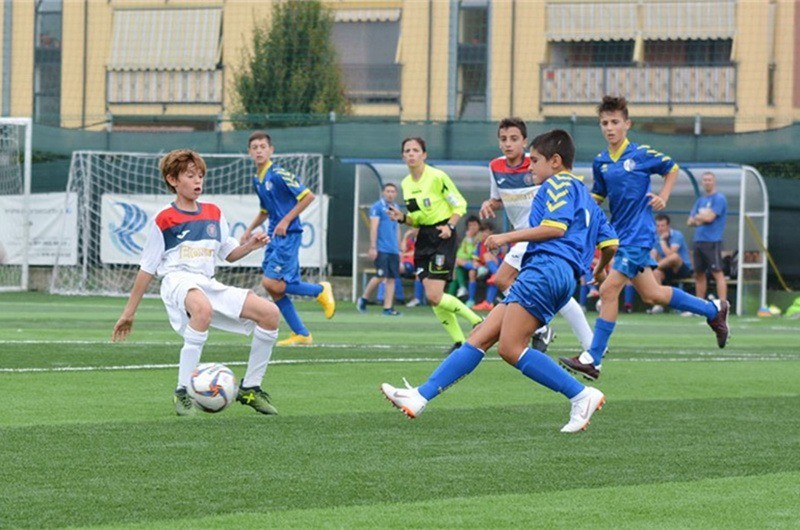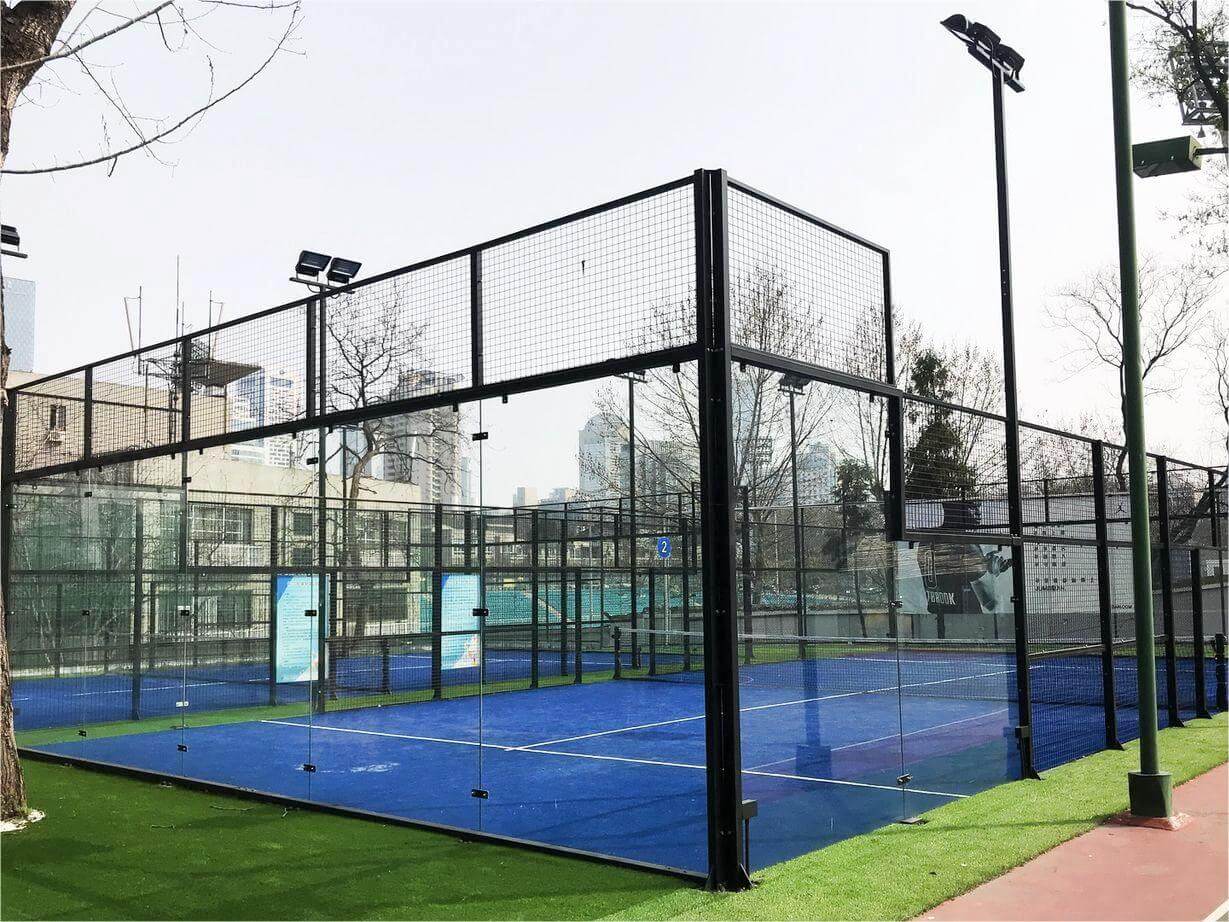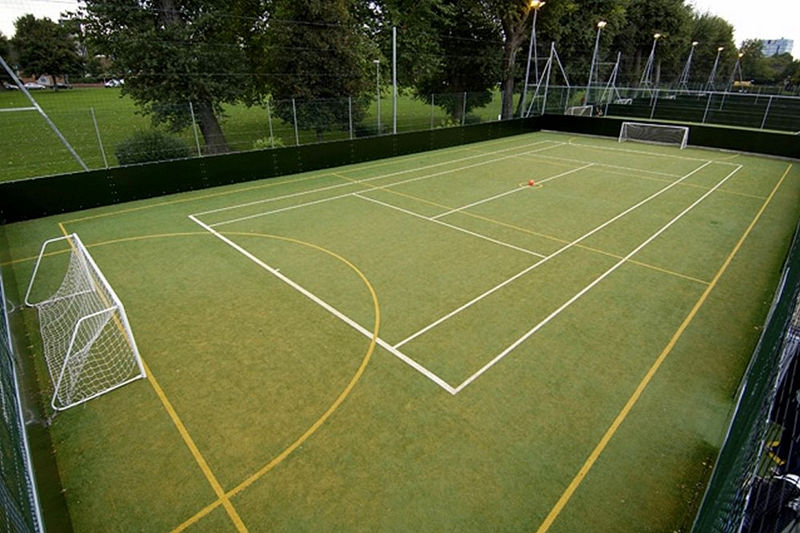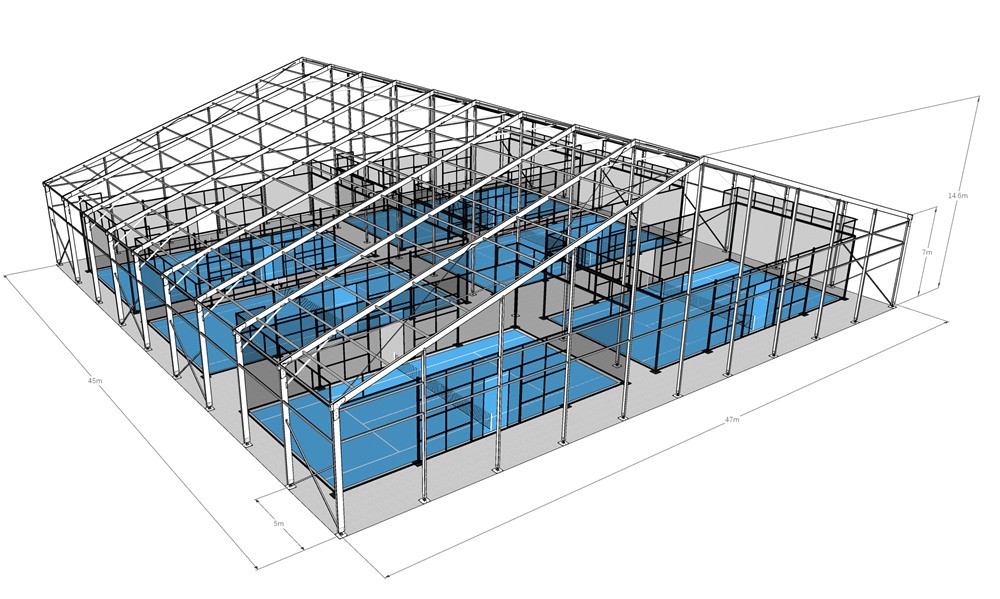กำลังวางแผนโครงการสนามพาเดลของคุณอยู่ใช่ไหม? หนึ่งในการตัดสินใจที่สำคัญที่สุดที่คุณต้องเผชิญคือการเลือกสนามพาเดลในร่มและกลางแจ้ง คู่มือฉบับสมบูรณ์นี้จะอธิบายความแตกต่างที่สำคัญ ค่าใช้จ่าย และประโยชน์ต่างๆ เพื่อช่วยให้คุณตัดสินใจเลือกสนามที่เหมาะสมกับสถานที่ สโมสร หรือชุมชนของคุณ
สารบัญ
- อะไรที่ทำให้สนามพาเดลในร่มและกลางแจ้งแตกต่างกัน?
- 🏢 สนามพาเดลในร่ม: คุณสมบัติและข้อมูลจำเพาะ
- 🌞 สนามพาเดลกลางแจ้ง: การออกแบบและประโยชน์
- 📐 ข้อมูลจำเพาะทางเทคนิค: สิ่งที่คุณจำเป็นต้องรู้
- 🌍 การพิจารณาเรื่องสภาพภูมิอากาศ: การเลือกที่ถูกต้อง
- 💰 การวิเคราะห์การลงทุน: ต้นทุนและผลตอบแทน
- 🔧 การพิจารณาการบำรุงรักษาและความทนทาน
- 🏆 กลยุทธ์ทางธุรกิจและการปฏิบัติการ
- การตัดสินใจของคุณ: คำถามสำคัญที่ต้องพิจารณา
- 🛠️ เหตุใดจึงควรเลือก Arturf สำหรับโครงการสนามพาเดลของคุณ
- บทสรุป: เส้นทางสู่ความสำเร็จในการเล่นพาเดล
อะไรที่ทำให้สนามพาเดลในร่มและกลางแจ้งแตกต่างกัน?
การเลือกสนามพาเดลระหว่างในร่มและกลางแจ้งมีผลต่อทุกสิ่ง ตั้งแต่ต้นทุนการก่อสร้างไปจนถึงประสบการณ์การเล่นของผู้เล่น การเข้าใจความแตกต่างเหล่านี้เป็นสิ่งสำคัญในการตัดสินใจลงทุนอย่างรอบรู้ ซึ่งสอดคล้องกับสถานที่ตั้ง สภาพภูมิอากาศ และเป้าหมายทางธุรกิจของคุณ
🏢 สนามพาเดลในร่ม: คุณสมบัติและข้อมูลจำเพาะ
ข้อกำหนดด้านโครงสร้าง
สนามพาเดลในร่มสร้างขึ้นภายในอาคารปิดและต้องพิจารณาทางสถาปัตยกรรมโดยเฉพาะ:
- ความสูงเพดานขั้นต่ำ: พื้นที่ว่าง 6 เมตรเหนือพื้นสนามทั้งหมด แต่ 8 เมตรจะแนะนำสำหรับการเล่นเกมขั้นสูง
- ระบบควบคุมสภาพอากาศ: ระบบ HVAC สำหรับการควบคุมอุณหภูมิและความชื้นตลอดทั้งปี
- ความสามารถในการบูรณาการ: มักเป็นส่วนหนึ่งของสถานที่กีฬาหลายประเภทหรือศูนย์ออกกำลังกายเชิงพาณิชย์
- การจัดการเสียง: การบำบัดเสียงเพื่อลดการส่งผ่านเสียงรบกวน
ข้อได้เปรียบหลัก
- ความเป็นอิสระของสภาพอากาศ: สนามในร่มให้สภาพการเล่นที่สม่ำเสมอไม่ว่าสภาพอากาศภายนอกจะเป็นอย่างไร ช่วยให้ใช้ประโยชน์จากสิ่งอำนวยความสะดวกได้สูงสุดและสร้างรายได้สูงสุด
- สภาพแวดล้อมที่ควบคุม: การเล่นเกมขั้นสูงได้รับการปรับปรุงด้วยความสูงของเพดานที่เหมาะสม โดยกำจัดตัวแปรต่างๆ เช่น ลม แสงแดด และความผันผวนของอุณหภูมิ
- ประสบการณ์พรีเมี่ยม: ระบบแสงไฟระดับมืออาชีพและการควบคุมสภาพอากาศสร้างสภาพแวดล้อมที่เหมาะสมที่สุดสำหรับการแข่งขัน การฝึกซ้อม และการเล่นแบบแข่งขัน
- เวลาทำการเพิ่มเติม: สนามในร่มสามารถเปิดให้บริการได้ตั้งแต่เช้าตรู่จนถึงดึกโดยไม่มีการรบกวนจากสภาพอากาศ
🌞 สนามพาเดลกลางแจ้ง: การออกแบบและประโยชน์
ลักษณะการก่อสร้าง
สนามพาเดลกลางแจ้งมีความยืดหยุ่นในการออกแบบและการจัดวาง:
- กลางแจ้งหรือปิดบางส่วน: มีตัวเลือกตั้งแต่สนามที่เปิดโล่งทั้งหมดไปจนถึงสนามที่มีหลังคาหรือหลังคาคลุมเท่านั้น
- การบูรณาการตามธรรมชาติ: ลงตัวกับรีสอร์ท โรงแรม หรือพื้นที่พักผ่อนหย่อนใจของชุมชน
- การระบายน้ำที่ดีขึ้น: ระบบการจัดการน้ำที่สำคัญป้องกันการสะสมของน้ำผิวดิน
- วัสดุที่ทนต่อรังสี UV: ส่วนประกอบพิเศษที่ออกแบบมาเพื่อทนต่อแสงแดดเป็นเวลานาน
ข้อได้เปรียบที่เป็นเอกลักษณ์
- สภาพแวดล้อมการเล่นที่เป็นธรรมชาติ: ผู้เล่นจำนวนมากชอบประสบการณ์กลางแจ้งที่แท้จริงพร้อมแสงธรรมชาติและการหมุนเวียนอากาศบริสุทธิ์
- การติดตั้งที่คุ้มค่า: ต้นทุนการก่อสร้างเริ่มต้นลดลงเนื่องจากความต้องการโครงสร้างพื้นฐานที่ลดลง
- การบูรณาการฉาก: สามารถออกแบบให้เข้ากับภูมิทัศน์ได้อย่างลงตัว มีทัศนียภาพและธรรมชาติแวดล้อมที่สวยงาม
- การขยายตัวที่ยืดหยุ่น: ง่ายต่อการเพิ่มสนามเพิ่มเติมหรือปรับเปลี่ยนเค้าโครงในพื้นที่กลางแจ้ง
📐 ข้อมูลจำเพาะทางเทคนิค: สิ่งที่คุณจำเป็นต้องรู้
ขนาดสนาม Padel อย่างเป็นทางการ
สนามพาเดลทั้งหมด ไม่ว่าจะเป็นในร่มหรือกลางแจ้ง จะต้องเป็นไปตามมาตรฐานของสหพันธ์พาเดลนานาชาติ (FIP):
- ขนาดสนาม: ยาว 20 เมตร กว้าง 10 เมตร วัดจากผนังด้านใน
- ข้อมูลจำเพาะสุทธิ: สูง 0.88 เมตรที่จุดศูนย์กลาง สูงถึง 0.92 เมตรที่เสา
- ความสูงของผนัง: ความสูงรวม 4 เมตร ส่วนล่างเป็นกระจกหรือวัสดุแข็ง 3 เมตร ส่วนบนเป็นตาข่ายโลหะ 1 เมตร
ข้อกำหนดเกี่ยวกับหญ้าเทียม
สนามพาเดลระดับมืออาชีพต้องใช้ระบบหญ้าเทียมเฉพาะทาง:
- ความสูงของกอง: ความสูงของเส้นด้าย 12-13 มม. เพื่อการเล่นที่เหมาะสมที่สุด
- การเติมทราย: ประมาณ 5 กิโลกรัมต่อตารางเมตรของทรายซิลิกาเพื่อความเสถียรของพื้นผิวและการตีกลับของลูกบอลที่สม่ำเสมอ
- เทคโนโลยีไฟเบอร์: ทรายช่วยทำให้สนามหญ้าแข็งแรง ป้องกันการลื่นไถล และปรับปรุงการยึดเกาะเพื่อความปลอดภัยของผู้เล่น
มาตรฐานแสงสว่าง
การส่องสว่างที่เหมาะสมเป็นสิ่งสำคัญสำหรับสนามทั้งสองประเภท:
- ข้อกำหนดกลางแจ้ง: ขั้นต่ำ 200 ลักซ์ พร้อมไฟสปอตไลท์ที่ติดตั้งสูงอย่างน้อย 6 เมตร
- ข้อกำหนดภายในอาคาร: ขั้นต่ำ 300 ลักซ์สำหรับการเล่นเพื่อความบันเทิง สองเท่าสำหรับการแข่งขันระดับมืออาชีพ
- มาตรฐานวิชาชีพ : การกระจายแสงที่สม่ำเสมอโดยมีตำแหน่งไฟส่องสว่างขั้นต่ำสี่ตำแหน่ง
🌍 การพิจารณาเรื่องสภาพภูมิอากาศ: การเลือกที่ถูกต้อง
สนามในร่มมีความโดดเด่นในด้าน:
- สภาพอากาศในฤดูหนาวที่รุนแรง: หิมะ อุณหภูมิเยือกแข็ง และน้ำแข็งทำให้การเล่นกลางแจ้งเป็นไปไม่ได้
- บริเวณที่มีฝนตกหนัก: ปริมาณน้ำฝนที่สม่ำเสมอจำกัดการใช้สนามกลางแจ้ง
- โซนอุณหภูมิสูงสุดขั้ว: สภาพอากาศทั้งร้อนจัดและหนาวจัดได้รับประโยชน์จากการควบคุมสภาพอากาศ
- สภาพแวดล้อมในเมือง: ความกังวลเกี่ยวกับคุณภาพอากาศและเสียงเอื้อต่อสถานที่ปิด
สนามกลางแจ้งเจริญเติบโตใน:
- ภูมิอากาศแบบเมดิเตอร์เรเนียน: สภาพอากาศอบอุ่น แห้งแล้ง มีปริมาณฝนจำกัด
- เขตทะเลทราย: ความชื้นต่ำและปริมาณน้ำฝนน้อยที่สุด (พร้อมโครงสร้างร่มเงาที่เหมาะสม)
- เขตร้อนชื้น: ด้วยการระบายน้ำที่เหมาะสมและวัสดุที่ป้องกันรังสียูวี
- สถานที่ตั้งรีสอร์ท: โดยที่การพักผ่อนหย่อนใจกลางแจ้งเป็นส่วนหนึ่งของประสบการณ์ของแขก
💰 การวิเคราะห์การลงทุน: ต้นทุนและผลตอบแทน
ต้นทุนการก่อสร้างเบื้องต้น
| ด้าน | สนามในร่ม | สนามกลางแจ้ง |
|---|---|---|
| โครงสร้าง | สูงขึ้นเนื่องจากข้อกำหนดด้านอาคารและระบบ HVAC | การลงทุนเริ่มต้นที่ต่ำกว่า ไม่จำเป็นต้องมีสิ่งที่แนบมา |
| พื้นฐาน | ฐานคอนกรีตมาตรฐานพร้อมคำนึงถึงสภาพภูมิอากาศ | จำเป็นต้องมีระบบระบายน้ำที่ได้รับการปรับปรุง |
| แสงสว่าง | ระบบ LED ที่ซับซ้อนพร้อมการกระจายแสงที่สม่ำเสมอ | การติดตั้งไฟสปอตไลท์แบบเรียบง่าย |
| วัสดุ | ข้อมูลจำเพาะมาตรฐาน สภาพแวดล้อมที่ได้รับการปกป้อง | ส่วนประกอบที่ทนต่อรังสียูวีและสภาพอากาศ |
ค่าใช้จ่ายในการดำเนินงาน
สนามในร่ม:
- ต้นทุนสาธารณูปโภคที่สูงขึ้น สำหรับการควบคุมสภาพอากาศและแสงสว่าง
- การบำรุงรักษาต่ำ เนื่องจากสภาพแวดล้อมที่ได้รับการคุ้มครอง
- รายได้ที่สม่ำเสมอ รุ่นตลอดปี
สนามกลางแจ้ง:
- ค่าสาธารณูปโภคขั้นต่ำ
- การบำรุงรักษาที่สูงขึ้น และความถี่ในการเปลี่ยนส่วนประกอบ
- ขึ้นอยู่กับสภาพอากาศ ความผันผวนของรายได้
🔧 การพิจารณาการบำรุงรักษาและความทนทาน
การบำรุงรักษาสนามในร่ม
ข้อดี:
- ได้รับการคุ้มครอง จากการเสื่อมสภาพจากรังสี UV และความเสียหายจากสภาพอากาศ
- เพิ่มความทนทานของสนามหญ้า ด้วยระบบเติมทรายที่เหมาะสม
- ลดความถี่ในการทำความสะอาด เนื่องจากมีเศษซากสะสมน้อยมาก
- การบำรุงรักษาที่คาดการณ์ได้ ตารางเวลา
ความต้องการ:
- การบำรุงรักษาระบบ HVAC และการเปลี่ยนไส้กรอง
- คุณภาพอากาศภายในอาคาร การจัดการ
- การบำรุงรักษาระบบไฟส่องสว่าง และการเพิ่มประสิทธิภาพการใช้พลังงาน
การบำรุงรักษาสนามกลางแจ้ง
ความท้าทาย:
- การตรวจสอบตามปกติ ของสารเคลือบและวัสดุที่ทนต่อรังสียูวี
- ระบบระบายน้ำ การทำความสะอาดและการบำรุงรักษา
- การซ่อมแซมที่เกี่ยวข้องกับสภาพอากาศ และการเปลี่ยนชิ้นส่วน
- การเตรียมตัวตามฤดูกาล และโปรโตคอลการป้องกัน
แนวทางปฏิบัติที่ดีที่สุด:
- มืออาชีพรายไตรมาส การตรวจสอบ
- ซ่อมแซมทันที ของความเสียหายจากสภาพอากาศ
- การรักษาเชิงป้องกัน เพื่อป้องกันรังสี UV และความชื้น
- การจัดเก็บอย่างเหมาะสม ของอุปกรณ์ที่ถอดออกได้
🏆 กลยุทธ์ทางธุรกิจและการปฏิบัติการ
สนามในร่ม: การใช้งานที่เหมาะสม
- สโมสรพาเดลเชิงพาณิชย์: เพิ่มรายได้สูงสุดผ่านความพร้อมใช้งานที่สม่ำเสมอ
- ศูนย์ออกกำลังกาย: การบูรณาการกับสมาชิกและบริการยิมที่มีอยู่
- สิ่งอำนวยความสะดวกขององค์กร: โปรแกรมส่งเสริมสุขภาพพนักงานและความบันเทิงสำหรับลูกค้า
- สถาบันการศึกษา: โครงการพลศึกษาและกีฬาตลอดทั้งปี
- สถานที่จัดการแข่งขัน: การเป็นเจ้าภาพจัดการแข่งขันระดับมืออาชีพและมือสมัครเล่น
สนามกลางแจ้ง: สถานการณ์ที่สมบูรณ์แบบ
- โรงแรมและรีสอร์ท: กิจกรรมนันทนาการและโปรแกรมสำหรับแขก
- ศูนย์นันทนาการสาธารณะ: กีฬาชุมชนและการเข้าถึงราคาไม่แพง
- โครงการที่อยู่อาศัย : การปรับปรุงสิ่งอำนวยความสะดวกสำหรับมูลค่าทรัพย์สิน
- ชมรมกีฬา: เสริมสิ่งอำนวยความสะดวกกลางแจ้งที่มีอยู่
- สิ่งอำนวยความสะดวกตามฤดูกาล: ค่ายฤดูร้อนและสถานที่พักผ่อน
โซลูชันไฮบริด: สิ่งที่ดีที่สุดของทั้งสองโลก
สถานที่เล่นพาเดลที่ประสบความสำเร็จหลายแห่งผสมผสานสนามในร่มและกลางแจ้งเพื่อเพิ่มความยืดหยุ่นและความน่าดึงดูดสูงสุด:
- ตัวเลือกการสำรองข้อมูลสภาพอากาศ สำหรับผู้ที่ชื่นชอบกิจกรรมกลางแจ้ง
- ระดับราคาที่แตกต่างกัน สำหรับกลุ่มลูกค้าที่หลากหลาย
- เพิ่มขีดความสามารถ สำหรับการแข่งขันและกิจกรรมต่างๆ
- เพิ่มความน่าดึงดูดใจทางการตลาด และการแยกสิ่งอำนวยความสะดวก
การตัดสินใจของคุณ: คำถามสำคัญที่ต้องพิจารณา
ก่อนที่จะสรุปการลงทุนในสนามพาเดลของคุณ ควรประเมินปัจจัยสำคัญเหล่านี้:
การวิเคราะห์สภาพภูมิอากาศและที่ตั้ง
- ปริมาณน้ำฝนเฉลี่ย ช่วงอุณหภูมิ และรูปแบบสภาพอากาศตามฤดูกาลในภูมิภาคของคุณเป็นอย่างไร
- สนามกลางแจ้งสามารถให้เล่นได้กี่วันต่อปี?
- มีกฎระเบียบหรือข้อจำกัดในพื้นที่เกี่ยวกับสิ่งอำนวยความสะดวกกีฬากลางแจ้งหรือไม่?
การประเมินรูปแบบธุรกิจ
- โรงงานของคุณจะเปิดดำเนินการตลอดทั้งปีหรือตามฤดูกาล?
- ฐานลูกค้าเป้าหมายของคุณคืออะไร: ผู้เล่นเพื่อการพักผ่อนหย่อนใจ นักกีฬาแข่งขัน หรือ นักท่องเที่ยว?
- การสร้างรายได้ที่สม่ำเสมอมีความสำคัญต่อแผนธุรกิจของคุณมากเพียงใด?
การพิจารณาเรื่องงบประมาณและระยะเวลา
- เงินทุนสำหรับการก่อสร้างเบื้องต้นของคุณมีเท่าไร?
- คุณสามารถรับมือกับต้นทุนการดำเนินงานต่อเนื่องที่สูงขึ้นสำหรับสิ่งอำนวยความสะดวกในร่มได้หรือไม่
- คุณมีกำหนดเวลาสำหรับการเสร็จสิ้นโครงการและการสร้างรายได้อย่างไร?
แผนการขยายในอนาคต
- ในอนาคตคุณจะเพิ่มศาลเพิ่มเติมหรือไม่?
- มีข้อจำกัดด้านพื้นที่ที่ทำให้ตัวเลือกหนึ่งเหนือกว่าอีกตัวเลือกหนึ่งหรือไม่
- การตัดสินใจครั้งนี้สอดคล้องกับเป้าหมายการพัฒนาสิ่งอำนวยความสะดวกในระยะยาวของคุณอย่างไร
🛠️ เหตุใดจึงควรเลือก Arturf สำหรับโครงการสนามพาเดลของคุณ
ในฐานะผู้ผลิตหญ้าเทียมและสนามพาเดลชั้นนำในประเทศจีน Arturf จัดจำหน่ายผลิตภัณฑ์สนามพาเดลคุณภาพสูงทั่วโลก ความเชี่ยวชาญของเราประกอบด้วย:
ผลิตภัณฑ์ศาลพรีเมี่ยม:
- ระบบหญ้าเทียมระดับมืออาชีพ ด้วยความสูงของกองที่เหมาะสม 12-13 มม. และข้อกำหนดการเติมทรายที่เหมาะสม
- แผงกระจกและระบบรั้ว ตอบสนองมาตรฐานความปลอดภัยสากล
- ส่วนประกอบของศาลที่สมบูรณ์ ออกแบบมาเพื่อการใช้งานทั้งภายในและภายนอกอาคาร
- การจัดส่งทั่วโลก กับพันธมิตรด้านโลจิสติกส์ที่เชื่อถือได้
การผลิตที่มีคุณภาพ:
- ผลิตภัณฑ์ที่สอดคล้องกับ FIP การปฏิบัติตามข้อกำหนดอย่างเป็นทางการของศาล
- วัสดุที่ทนต่อรังสียูวี เพื่อความทนทานกลางแจ้ง
- ส่วนประกอบที่ผ่านการทดสอบสภาพอากาศ เหมาะกับสภาพอากาศที่หลากหลาย
- การผลิตที่ได้รับการรับรองมาตรฐาน ISO การรับประกันคุณภาพที่สม่ำเสมอ
บริษัท โกลบอล ซัพพลาย โซลูชั่นส์:
- การจัดส่งระหว่างประเทศ สู่โครงการทั่วโลก
- ข้อมูลจำเพาะผลิตภัณฑ์ครบถ้วน และเอกสารทางเทคนิค
- ความร่วมมือกับผู้รับเหมาท้องถิ่น และผู้ติดตั้งทั่วโลก
- การสนับสนุนด้านเทคนิค สำหรับการเลือกผลิตภัณฑ์และข้อมูลจำเพาะ
บทสรุป: เส้นทางสู่ความสำเร็จในการเล่นพาเดล
การเลือกสนามพาเดลในร่มและกลางแจ้งขึ้นอยู่กับสถานที่ตั้ง สภาพอากาศ งบประมาณ และวัตถุประสงค์ทางธุรกิจของคุณ สนามในร่มให้ผลตอบแทนคงที่และมีศักยภาพในการสร้างรายได้ตลอดทั้งปี แต่ต้องใช้เงินลงทุนเริ่มต้นที่สูงกว่า สนามกลางแจ้งให้ผลตอบแทนที่คุ้มค่าและดึงดูดใจผู้เข้าแข่งขัน แต่อาจมีข้อจำกัดด้านสภาพอากาศ
ความสำเร็จในทั้งสองทางเลือกต้องอาศัยการก่อสร้างที่มีคุณภาพ วัสดุที่เหมาะสม และการติดตั้งในพื้นที่โดยมืออาชีพ การร่วมมือกับผู้ผลิตที่มีประสบการณ์อย่าง Arturf จะช่วยให้คุณมั่นใจได้ว่าผลิตภัณฑ์สนามพาเดลของคุณเป็นไปตามมาตรฐานสากลและมอบคุณค่าในระยะยาว
พร้อมที่จะจัดหาผลิตภัณฑ์สนามพาเดลคุณภาพหรือยัง? ติดต่อทีมผู้เชี่ยวชาญของเราเพื่อรับข้อมูลจำเพาะของผลิตภัณฑ์ ราคา และข้อมูลการจัดส่งที่เหมาะกับสถานที่ตั้งและความต้องการโครงการของคุณ
คู่มือนี้ให้ข้อมูลทั่วไปเกี่ยวกับการวางแผนสนามพาเดล สำหรับข้อกำหนดทางเทคนิคเฉพาะและกฎหมายอาคารท้องถิ่น โปรดปรึกษาวิศวกรมืออาชีพและหน่วยงานท้องถิ่นในพื้นที่ของคุณ




